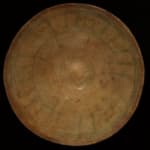Glazed Earthenware Bowl, 1200 BCE - 1300 CE
Glazed Earthenware
5.6 x 2.5
JB.1139
Coarse stonepaste, celadon slip with blue-green detailing beneath crackled, transparent glaze; a deep well with steep, vaguely curved walls rising from short foot-ring; glaze has collected in small pool at...
Coarse stonepaste, celadon slip with blue-green detailing beneath crackled, transparent glaze; a deep well with steep, vaguely curved walls rising from short foot-ring; glaze has collected in small pool at centre of bowl; radial bands to cavetto with single band beneath and parallel bands above.
The adoption of fritware – or stonepaste – in 12th century radicalised ceramic production throughout the Islamic empire. Abu ‘l-Qasim’s treatise of ACE 1301 describes its composition as ten parts ground quartz, one part clay and one part glaze mixture. An alkaline as opposed to lead glaze was applied.
The new-composite allowed for, among other things, vessels to be thrown and turned to a remarkable thinness, sometimes only two or three millimetres thick. This bowl is testament not only to the versatility of fritware but also, spread of new technology throughout the empire.
Fritware was developed to compete with imported Chinese wares that flooded the market via the Silk Route, which had for centuries passed through Central Asia. The shape and colour closely imitates Chinese celadon. However, it is difficult to say for sure whether the base slip was initially white and has diminished over time or due to some reaction with the surface material or was always green. Though, it is known that celadon was widely admired throughout the empire and there are virtually no archaeological sites in the near and Middle East where such fragments have not been excavated.
This piece serves as a charming little piece of evidence that potters were testing the realm of new technologies in response to competition from Chinese products. It encapsulates the response of potters new influences and a desire to imitate and adopt rather than ignore.
The adoption of fritware – or stonepaste – in 12th century radicalised ceramic production throughout the Islamic empire. Abu ‘l-Qasim’s treatise of ACE 1301 describes its composition as ten parts ground quartz, one part clay and one part glaze mixture. An alkaline as opposed to lead glaze was applied.
The new-composite allowed for, among other things, vessels to be thrown and turned to a remarkable thinness, sometimes only two or three millimetres thick. This bowl is testament not only to the versatility of fritware but also, spread of new technology throughout the empire.
Fritware was developed to compete with imported Chinese wares that flooded the market via the Silk Route, which had for centuries passed through Central Asia. The shape and colour closely imitates Chinese celadon. However, it is difficult to say for sure whether the base slip was initially white and has diminished over time or due to some reaction with the surface material or was always green. Though, it is known that celadon was widely admired throughout the empire and there are virtually no archaeological sites in the near and Middle East where such fragments have not been excavated.
This piece serves as a charming little piece of evidence that potters were testing the realm of new technologies in response to competition from Chinese products. It encapsulates the response of potters new influences and a desire to imitate and adopt rather than ignore.



